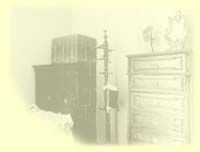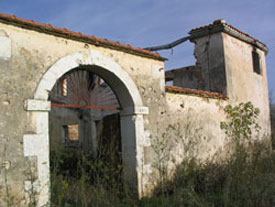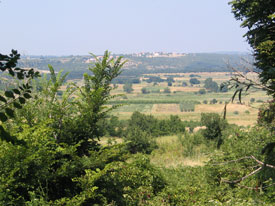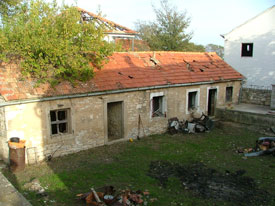
* Ravni Kotari and Islam area
The houses of Islam Latinski are lined along the main road seamlessly joining the houses of Islam Grčki. Before the war Islam Grčki had around 1,100 inhabitants and Islam Latinski around 950. Contrary to most regions of the former so-called Krajina, which are barren and economically unattractive, villages are in a fertile valley called Ravni Kotari. Before the war both villages were relatively prosperous, thanks to rich soil, plenty of sun and water (there are many springs around) and excellent conditions for agricultural production, as well as due to the closeness of the markets for their products (Adriatic coastal towns and hotels).

Frontier and border regions often have specific and distinct development, which influences the character of the people living there and creates the diverse cultural achievements. Due to the importance of the border regions for the safety of each country, frequently in history governments put their best creative and material efforts into these regions. This is especially true in trying times that in tumultuous history of Europe were very frequent. Numerous beautiful castles, fortified mansions and churches, that adorn coastal parts of England and continental Europe, present and past France/Germany border regions, parts of Poland, Czech Republic, etc. They all are the testimony of the vibrant, exciting and inevitably creative way of living in a constant insecurity and dangers of the frontier regions. Border region between two powerful entities in 17th century Europe, the Venetian Republic and the Ottoman Empire was by no means an exception. Even more so, this border region, having all the above mentioned specifics of the frontier, was indeed additionally special: it was not merely the border between two different nations and/or two different states; it was both the divide and the contact line between large and long-lasting civilizations - between European Christendom and the Ottoman Islamic world. The toponym Islam Grčki-Islam Latinski is a unique and precise symbol of the clash and intermixing of these so different worlds. The toponym consists of three words: of ISLAM, of GRČKI (which means Greek, i.e. Orthodox Christian) and of LATINSKI (which means Latin, i.e. Roman Catholic).

The twin villages Islam Grčki and Islam Latinski have been populated both with Roman Catholic and Serb Orthodox populations for at least four centuries. In old documents and maps the same family names can be found to be living and owning land for centuries at this same location. For most of history these people of different religion and different ethnic origins lived together and side-by-side, often marrying between themselves, and sharing common fates and hardships of people living on the crossroads of civilizations. Even during the Second World War, with all its evil temptations, they lived through it mostly peacefully and practically without animosities or atrocities (contrary to most of the rest of Croatia and the Balkans), helping each other to get through these terrible times. Villagers of Islam Latinski and Islam Grčki shared common vital economic interests and used to solve them together. For example, they participated in the joint building of the elementary school, helping to transform former concrete road into an asphalt road, establishing electricity lines, water supply lines, etc.; (the installation of phone lines was interrupted by the war). They shared this common elementary school (from the first to eighth grade) which was located in Islam Grčki, but was attended by children from both villages. Children shared not only school benches and many other school activities, but also friendships, destinies… They played together in the school sport’s grounds (football and other sports), danced Sunday evenings in their Youth Club adjoined to the school. Many teachers in the school were locals, either of Croatian or Serbian origin, returning to their village after completing education. Understandably, there are a lot of mixed marriages in villages Islam Grčki and Islam Latinski. Another undoubtedly common link was the castle: villagers from both Islams were always very proud and fond of the castle and in many different ways it meant a great deal to them.
During the last war the division line between the Krajina rebels and the Croatian army went right through the twin villages, shifted through this region back and forth and both Islams suffered enormous devastation. During almost four years of war the population saw both armies and was exposed to all the sufferings of the war. Both Islam Latinski and Islam Grčki were heavily damaged and partly demolished. While most of Croats returned after the war, all of the Serb-origin villagers are still in exile. Part of Islam Grčki’s population fled to Bosnia and Herzegovina or further to Serbia or out of the Balkans. Part of them is dispersed throughout Croatia mostly with relatives or friends, doing odd jobs to survive.

website by Vidagents


